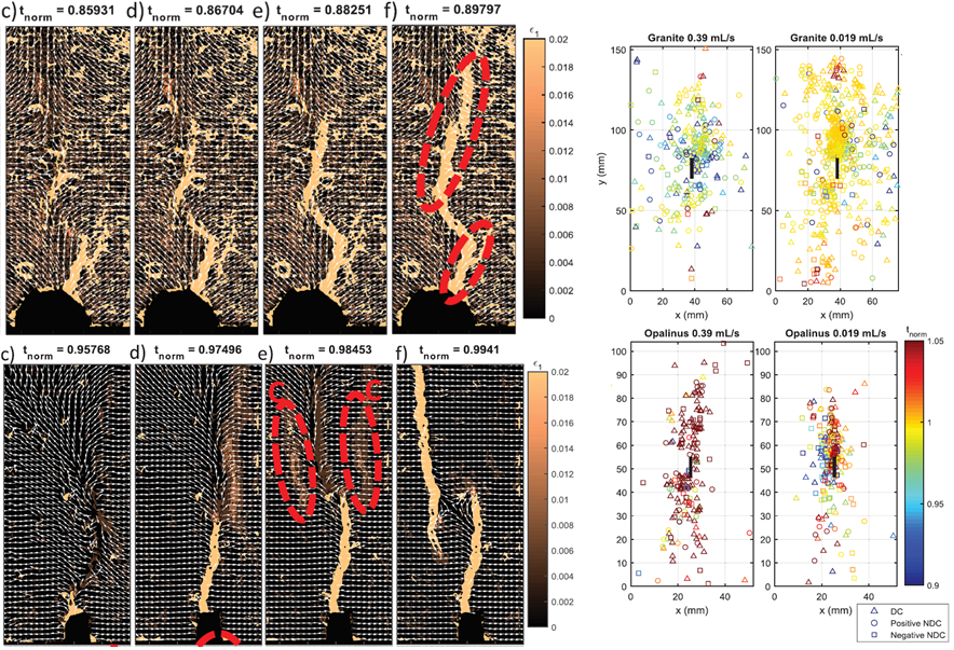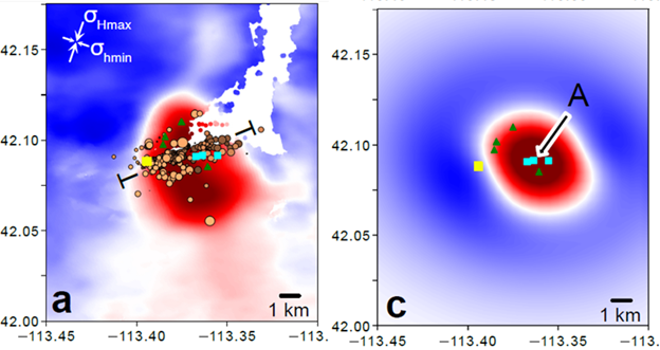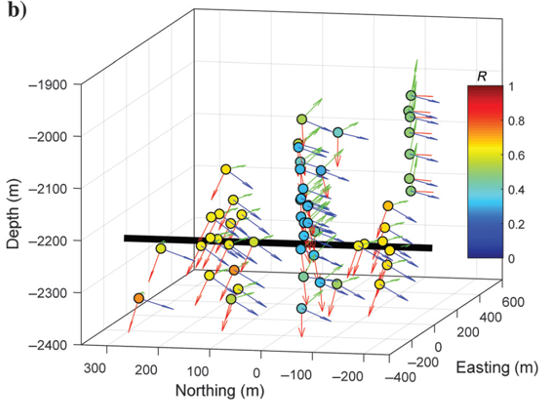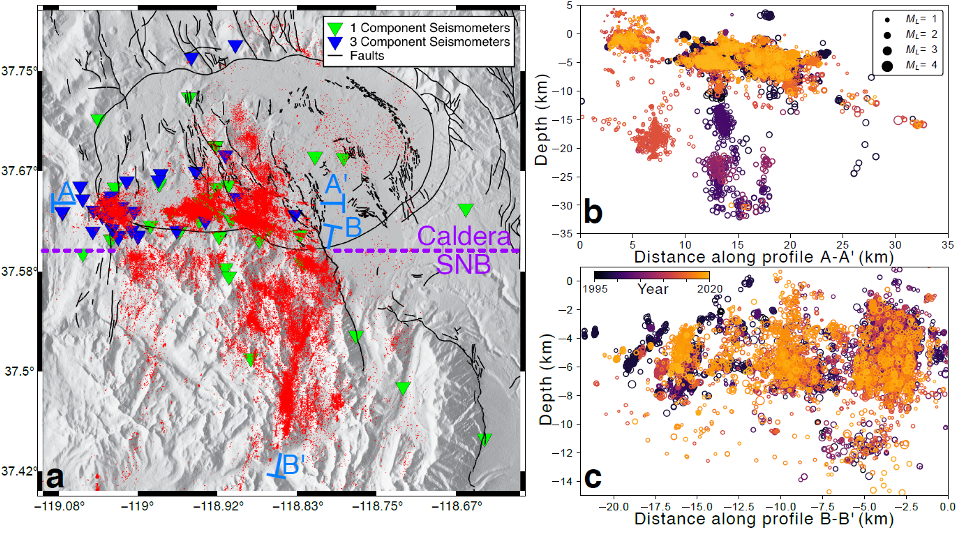Bing Li
Contact
Bing Li
Assistant Professor, Department of Civil and Environmental Engineering
Tel:+1 (519) 661-2111 ext. 86096
bing.li@uwo.ca
Research
I am interested in topics at the intersection of rock engineering, fracture mechanics, permafrost, and geophysics, with a specific focus on rockfalls, permafrost resilience, and fluid-induced (micro-) earthquakes. These earthquakes may be triggered by fluid diffusion or stress changes in industrial settings such as geothermal energy production, oil&gas extraction, carbon sequestration, nuclear waste storage, hydroelectric reservoirs, and mining, as well as natural settings such as volcanoes. The phenomena are investigated using experiments and modelling at the laboratory scale, and modelling at the field scale. The primary data of interest are seismic waveforms and imaging (photographic, inSAR, or laser interferometry), which are processed using physics-based, statistical and machine learning methods to better understand and eventually predict the onset of earthquake and fracturing events.
Projects:
- Induced seismicity at Tony Creek experimental site, Alberta
- Tremor and geodetic deformation at Aquistore site, Saskatchewan
- Deep learning characterisation of acoustic emissions data from rock fracture processes
- 3D printing for characterisation of rock faults
- Imaging for calibration of slope stability systems
- Calibration of rockfall models using Doppler radar
- Drone- and ground-based imaging of rock slopes
- Stability of small modular reactor (SMR) foundations in permafrost
Research Highlights
Extents of acoustic emissions and imaging in hydraulic fracturing of granite and shale
In many subsurface energy systems such as geothermal, oil&gas, and nuclear waste storage, it is critical to monitor the creation and opening of fracture networks. Often, these fracture networks are only demarcated by the location and timing of micro-earthquakes generated alongside the fractures. In this body of work, we study the relationship between the strains and displacements generated by rock fractures which can be directly imaged only in the lab, and micro-earthquakes which can be indirectly measured in the lab and the field. This provides us a better understanding of the true geometry of the permeable fracture network generated in the field, given only micro-earthquake data.
References:
Li, B.Q., Einstein, H.H. (2017) Comparison of visual and acoustic emission observations in a four point bending experiment on barre granite. Rock Mechanics and Rock Engineering 50 (9), 2277-2296
Li, B.Q., Goncalves da Silva, B.M., Einstein, H.H. (2019) Laboratory hydraulic fracturing of granite: Acoustic emission observations and interpretation. Engineering Fracture Mechanics 209, 200-220
Li, B.Q., Einstein, H.H. (2019) Direct and microseismic observations of hydraulic fracturing in barre granite and opalinus clayshale. Journal of Geophysical Research: Solid Earth 124 (11), 11900-11916
Li, B.Q., Einstein, H.H. (2020) Normalized radiated seismic energy from laboratory fracture experiments on Opalinus clayshale and Barre granite. Journal of Geophysical Research: Solid Earth 125 (3), e2019JB018544

Geomechanical parameter calibration using geodetic data
In geotechnical and subsurface energy systems, there is often significant uncertainty on the material properties on/in which the structure is constructed. This uncertainty partly stems from a lack of data, which is costly to acquire. Thus, it is critical to calibrate the true material properties of the constructed system, in order to correctly model its behaviour. In these works, the objective is to calibrate a fast physics-based geomechanical model of hydrothermal and oil&gas activities. The calibration is conducted by matching the modelled surface displacements to true surface displacements derived from public satellite inSAR data. This model is deployed to simulate the diffusion of pore pressures and corresponding poroelastic stress changes, which can induce earthquake events. Eventually, these types of methods can be used to deployed to dynamically monitor various fluid injection and extraction activities.
References:
Li, B.Q., Khoshmanesh, M., Avouac, J.-P. (2021) Surface Deformation and Seismicity Induced by Poroelastic Stress at the Raft River Geothermal Field, Idaho, USA. Geophysical Research Letters
Li, B.Q., Avouac, J.-P., Ross, Z.E., Du, J., Rebel, E. (2020) Induced seismicity in the Dallas-Fort Worth Basin: Enhanced seismic catalogue and evaluation of fault slip potential. SEG International Exposition and Annual Meeting
Li, B.Q., Khoshmanesh, M., Avouac, J.-P., Ross, Z.E., Du, J., Rebel, E. (2020) Induced Seismicity in the Dallas-Fort Worth Basin: Enhanced Seismic Catalogue, Calibration with Geodetic Measurements, and Evaluation of Fault Slip Potential. AGU 2020 Abstract

Development of a methodology for inversion of stress orientations and magnitudes from microseismicity
The subsurface stress field can be highly heterogeneous in the presence of complex fracture networks and/or excavations, which adds uncertainty to future design and operational decisions. Here, we develop and deploy an algorithm that solves for a spatially-varying stress tensor by clustering micro-earthquakes in space, and then applying a modified damped stress inversion that accounts for the distances between earthquake clusters. The methodology has been automated and deployed in oil&gas workflows for unconventional shale plays, and helps operators better understand the true subsurface stress conditions.
References:
Li, B.Q., Du, J. (2020) A methodology for unstructured damped stress inversion of microseismic focal mechanisms: Application to the Vaca Muerta Formation, Argentina. Geophysics 85 (2), KS39-KS50
Li, B.Q., Du, J. (2019) A methodology for unstructured damped stress inversion of microseismic focal mechanisms. Unconventional Resources Technology Conference, Denver, Colorado, 22-24 July 2019
(In preparation) Niu, Z., Li, B.Q., Moradian, Z. (2021) “Verification of a set of Moment Tensor Inversion and Decomposition Methods and its Application to an Experiment”.

Naturally induced seismicity in volcanic settings
Volcanic activity can trigger swarms of earthquakes, which may or may not be associated with an oncoming eruption. Here, we develop a deep learning algorithm to detect small-magnitude earthquakes under the Long Valley Caldera in California, which we precisely locate to understand the swarms’ spatial and temporal characteristics. We find that they change dramatically when crossing the boundary of the volcano. Swarms outside the caldera are typical faulting-type swarms where a single event triggers multiple subsequent events. Conversely, the swarms beneath the caldera tend to nucleate at the boundary with the underlying ancient magma chamber and ascend in a chain-like topology. Super cool.
Reference:
Li, B.Q., Smith, J.D., Ross, Z.E. (2021) Basal nucleation and the prevalence of ascending swarms in Long Valley Caldera. Science Advances


